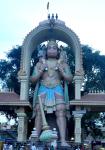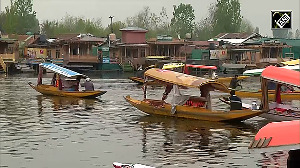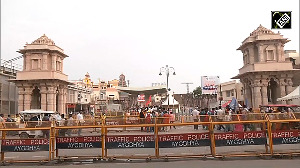But what a profusion of flowers! My favorite is the Indian laburnum, the kani-konna, with its bell of golden flowers arranged like one of those multi-layered oil lamps with tens of wicks all round. This seasonal flower, which is one of the main ingredients for the Vishu festival soon, absolutely outclasses its more common neighbour, the laburnum, the konna, which, on its own, looks rather good, but next to the kani-konna, is pretty pedestrian, its gold looking like an impostor compared to the real thing. But I remember with fondness a particular laburnum tree, when I was living in Chennai some years ago near Adyar, which used to cover my car with yellow flowers.
The kani-konna is one of those signature Kerala specialties, along with golden banana chips, and the border of gold on the off-white traditional Kerala mundum-neriyathum, the two-piece sari.
Then there is the jacaranda, in indigo expanses along the tree-tops. Bangalore seems to be best for these flowers, and there is a carpet of them on the roads. I used to live, years ago, off M G Road, and on the (then-) quiet side streets there used to be a profusion of them, freshly fallen in the morning.
The flame of the forest, with its brilliant orange-red flowers, is beautiful. I guess this is one of the more common wild flower-bearing trees in India. And there are also the bougainvilleas with their fragile, paper-like flowers in varying shades; and back in Kerala there is a profusion of those temple-flowers: bright-red chemparathi, hibiscus; red, orange and yellow thetti, ixora; fragrant pichi, lavender, and the ubiquitous white mulla, jasmine. I am also partial to the multi-hued and poisonous arali, oleander; and the fragrant pala, which is beloved of yakshis, feared naiads, wood-nymphs.
I remember the cherry-blossoms of Washington, DC, which I only saw once -- an amazing carpet of flowers covering the place. And the Golden Gate Park has its own sakura, cherry-blossom time. Japan itself is celebrating the arrival of these pretty-in-pinkish-white blossoms, that, alas, have a very short shelf life.
When Spring is here, there is much to celebrate, despite all the dependable atrocities all over the place: war, murder, land-grab, bigotry. A few years ago, I wrote in Silent Spring, Holy Spring
But no matter. As the poet said, young men's (and young women's) hearts turn to thoughts of love when Spring is in the air. And then come all those festivals. In Kerala, this is the season for temple festivals: Utsavams, including the various ponkalas at the Devi temples, when women cook sweetened rice.
But the king of all this is Holi, which, alas, I have never observed full-force first hand. It is not celebrated in Kerala, and when I lived in Chennai and Bangalore, it was but a pale shadow of what it must be in northern India. And all that colour: it is the quintessential Indian festival for it celebrates the riotous colour that is India's hallmark. This is one of the reasons that black-and-white photography never does justice to India -- without its overwhelming colour, India is so much less interesting!
And then there is the other festival of Spring, Vishu, which is due on April 15th. It is not, contrary to popular belief, the Malayalam New Year. It is a Spring festival, although it does coincide with the Tamil New Year and the solar new year. The Malayalam calendar, oddly enough, starts in August, with Chingam, Leo, and then goes through the rest of the astrological calendar.
But, in contrast to the festivities, I happened to be in Kerala when an uncle of mine passed away, and I attended the funeral. It has been some years since I witnessed a Kerala funeral, and once again there was a profusion of flowers: oleander, yellow jamanthi, marigold; orange kanakambaram, crossandra; jasmine. There were garlands made with mixed flowers.
Before an eight-wicked brass oil lamp burnished like gold, on a large banana leaf were laid out coconuts, plantains, and joss-sticks. The son and the son-in-law, the principal mourners, wore rings of darbha grass, and there was the traditional hymn to water, invoking the rivers Godavari, Ganga, Yamuna, Saraswati, etc. The son wore around his waist the red cloth that had wrapped the urn with the ashes.
A vathi, traditionally a barber, officiated, giving complex instructions on what to do. After the main mourners had done their bidding, it was the turn of the rest of the relatives to pick a few flowers, and with folded hands drop them on the urn, honoring the dead man's memory and praying for him. And then his ashes were to be immersed into the sea at Papanasam, near the ancient Janardhana temple in nearby Varkala.
Ashes to ashes, dust to dust. New life, and a death. The cycle was complete.
Comments welcome at my blog at https://rajeev2007.wordpress.com






 © 2025
© 2025